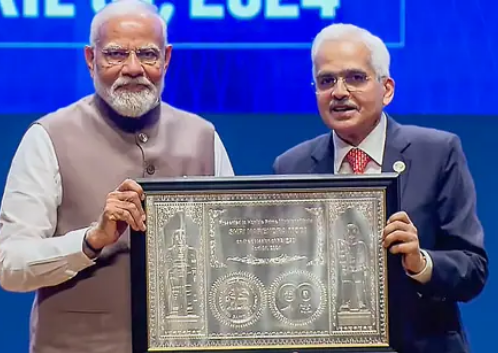Context:
The Prime Minister addressed the opening ceremony of the 90th anniversary celebrations of the Reserve Bank of India (RBI) in Mumbai.
More on the news:
- PM emphasized the need for India to enhance its economic self-reliance in the next decade to mitigate the impact of global crises.
- He commended the RBI’s proactive measures, including active price monitoring and fiscal consolidation, to maintain moderate inflation levels during the COVID-19 pandemic.
- He stressed the importance of striking a balance between inflation control and economic growth for developing countries.
- He emphasized the need for cybersecurity in the digital banking system and coordination between monetary and fiscal policies.
- A commemorative coin marking the 90th anniversary of the RBI was released by the Prime Minister.
Reserve Bank of India
- The RBI was established based on Hilton Young Commission’s recommendations.
- Established in 1935 under the Reserve Bank of India Act.
- Initially privately owned, but nationalized in 1949.
- The first Governor of the RBI was the Australian Sir Osborne Arkell Smith, one of the two managing governors of the Imperial Bank of India. Sir C D Deshmukh was the first Indian to become Governor.
Function:
- Fulfills all the roles typically associated with a central bank.
- Responsible for managing the money supply and credit in the Indian economy to maintain price stability (control inflation).
- Ensures the smooth functioning of the financial system by regulating commercial banks and other financial institutions.
- Acts as the government’s banker, managing its accounts and facilitating financial transactions.
- Holds the exclusive right to issue Indian rupee banknotes.
- Manages India’s foreign exchange reserves and regulates foreign exchange transactions.
Monetary Policies:
• Liquidity Adjustment Facility (LAF): The liquidity adjustment facility (LAF) of the Reserve Bank of India assists banks in adjusting their daily liquidity mismatches. Repo (repurchase agreement) and reverse repo are the two components of a LAF.
- Repo rate: The rate at which RBI lends short-term funds to commercial banks. This rate influences interest rates throughout the economy.
- Reverse Repo Rate: The Reserve Bank absorbs liquidity from banks on an overnight basis at a fixed interest rate in exchange for eligible government securities under the LAF. This interest rate is known as the Reverse Repo Rate.
- Cash reserve ratio (CRR): The portion of deposits that banks must hold as reserves with RBI. This helps control money supply in circulation.
- The Statutory Liquidity Ratio (SLR): It is the percentage of Net Demand and Time Liabilities (NDTL) that a bank must maintain in safe and liquid assets such as unencumbered government securities, cash, and gold.
- Open market operations (OMO): RBI buys or sells government securities to influence interest rates and liquidity in the financial system.

